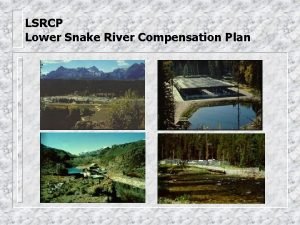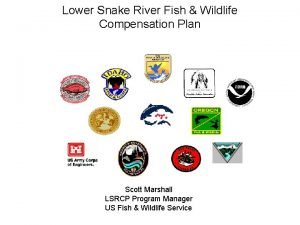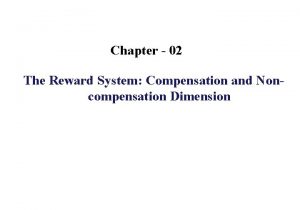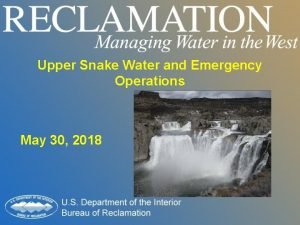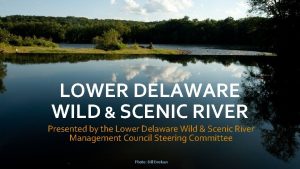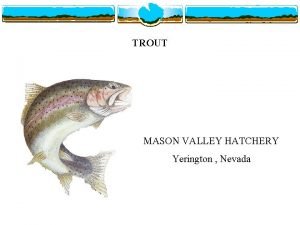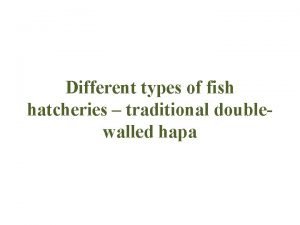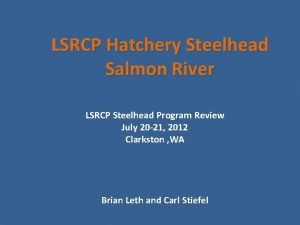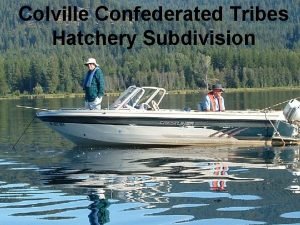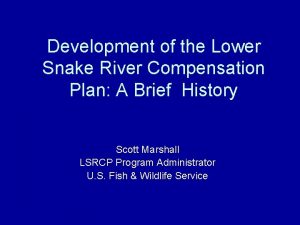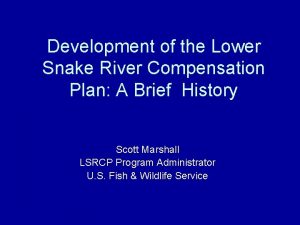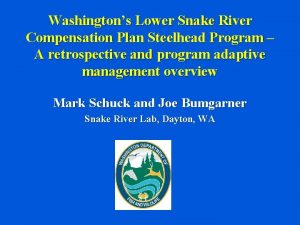LSRCP Lower Snake River Compensation Plan LSRCP Hatchery









- Slides: 9

LSRCP Lower Snake River Compensation Plan

LSRCP Hatchery Locations Snake River Clearwater River Sesesh River Mid Salm dle For on R k iver Salmon River Lemhi River South Fork Salmon River Pahsimeroi River Upper Salmon River East Fork Salmon River

LSRCP Compensation Objectives 25, 260 Steelhead 8, 000 Summer Chinook Salmon 20, 010 Spring Chinook Salmon

LSRCP Broodstock Management Chinook Salmon ->Local Broodstock ->Beginning with BY 93, all chinook marked Reserve Supplementation (Natural) ->Responsive to ESA, Supplementation Evaluation Steelhead ->Non-local broodstock ->All hatchery production (for fisheries) is marked ->Upper Salmon River only

LSRCP Adaptive Management Steelhead Size at release Acclimation Location of Release Hatchery Evaluation Studies ->Research, Monitoring, & Evaluation ->Steelhead and Chinook *optimize hatchery operations to meet compensation objectives *minimize impacts to natural populations; recognize conservation objectives

LSRCP Hatchery Evaluation Studies Steelhead Acclimation at Sawtooth Fish Hatchery Management Obj. : Number of returning adults can be increased and adult straying can be reduced by acclimating steelhead smolts prior to release. Research Question: Does acclimation of steelhead prior to release affect juvenile migration timing, juvenile migration success, adult return rate, age at return, and sex ratio of returning adults.

LSRCP Hatchery Evaluation Studies Steelhead Size at Release Biological Issue: Large steelhead smolts may be more predacious, preying on naturally produced salmonids, and may be more likely to residualize, and further impact naturally produced fish. Management Objective: Produce hatchery steelhead smolts for release at a size that optimizes high adult return rates and low residualism and predation rates. Research Question: Does hatchery steelhead smolt size-atrelease influence adult return rate, age at adult return, sex ratio of returning adults, juvenile migration timing, and juvenile PIT-tag interrogation rate.

LSRCP Hatchery Evaluation Studies Squaw Creek Release/Acclimation Pond (Steelhead) NATURES Rearing (Chinook) Chinook Size at Release Chinook spawner distribution in SFSR Recommendations for Steelhead Size at Release

Sawtooth Fish Hatchery – 2001 Broodstock Plan Adipose Clipped Supplement. Marked Unmarked (listed) Forecast female return 365 182 366 Broodstock 365 25 25 341 157 BY 01 females 365 50 498 Eggs 1, 642, 500 225, 000 2, 241, 000 Smolts (2003) 1, 231, 875 168, 750 156, 870 1, 232 169 157 Adults (2004 -2006) Natural Spawning
